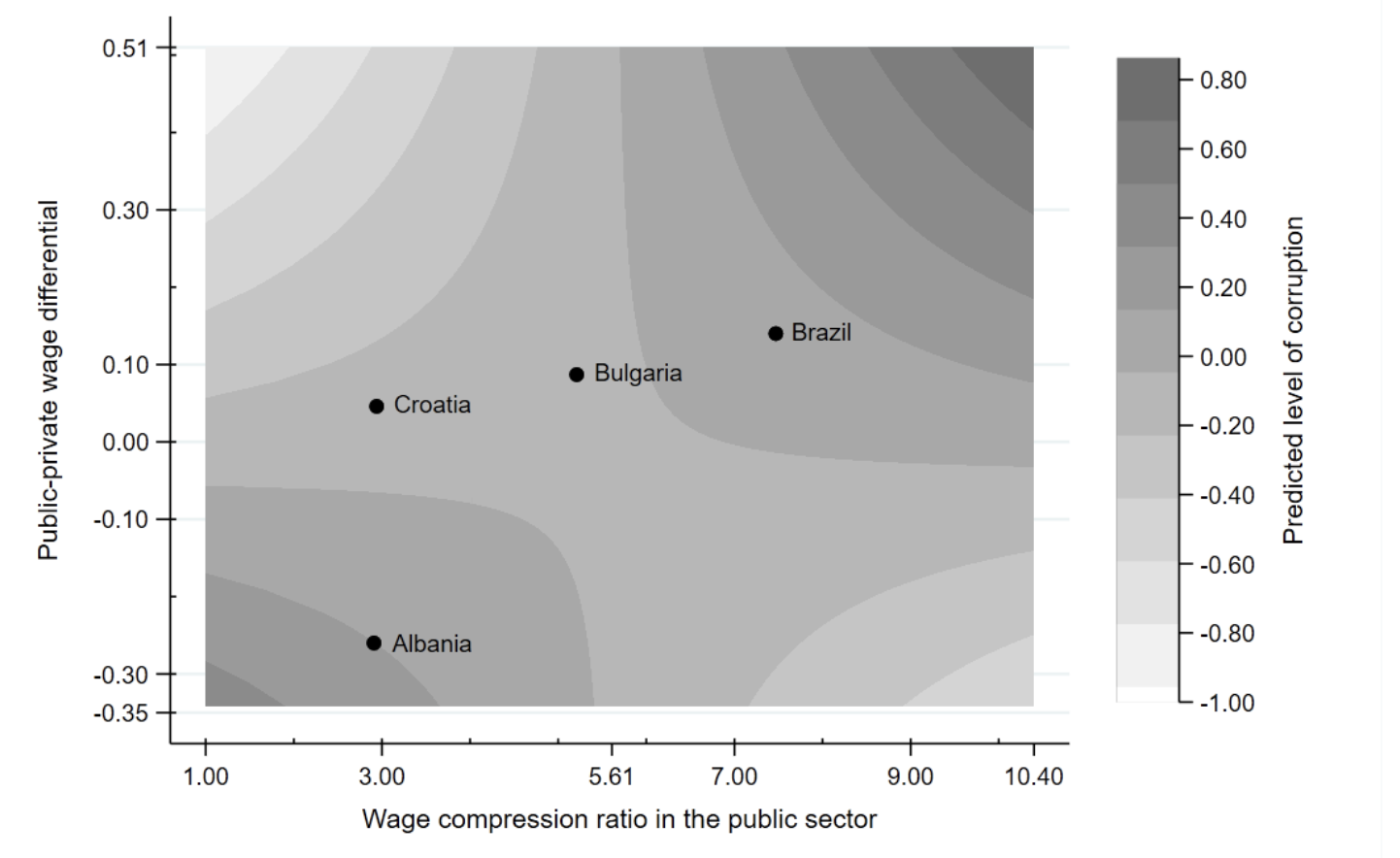Recommended
Anti-corruption policies in many countries rely on the notion that corruption is caused by low wages in the public sector. For example, in an attempt to curtail corruption, countries such as Argentina, Georgia, Ghana, Peru, Singapore, and others have implemented public sector reforms to increase the wages of government officials. However, the evidence on the effectiveness of such interventions on corruption is mixed. In a recent paper, we find that differences in public sector wage inequality play an important role in the relationship between public sector wages and inequality.
Design of the study
We use a newly available country-level panel data set to study the effect of public sector wages on corruption. The longitudinal structure of our data allows us to tackle a range of econometric issues that previous studies could not address. Our main variables on public and private sector wages come from the Worldwide Bureaucracy Indicators data set, which derives country-level indicators from micro-level labor force surveys. Differences between the public and private sector wages derived from macro data ignore the differences in workers’ human capital characteristics that lead to potential biases when compared with differences obtained from the micro-level surveys. Also, any distributional statistics, such as wage compression ratios, cannot be derived from macro-level data at all. In this way, we are able to address important measurement issues that plague the earlier literature. We focus on two variables: the public sector wage premium (estimated as a coefficient on the public sector employment dummy variable in the standard log-earnings regressions for each country) and the wage compression ratio (defined as a ratio of the 90th to the 10th percentiles of public sector employees’ weekly wages). We measure corruption by commonly used perception-based indicators produced by the World Bank, the World Economic Forum, and Transparency International and show that our results are robust to the use of alternative indicators.
The relationship between public sector wage inequality and corruption
Our main finding is that the impact of public sector wages on corruption depends on the existing wage inequality in this sector. Figure 1 illustrates this result by depicting a contour plot of the predicted levels of corruption as a function of the public-private wage differential and the wage compression ratio, defined as the ratio between the pay of the highest and lowest earners on the public sector pay scale. The contours indicate the areas in which predicted corruption lies within a particular range, with darker colors indicating higher corruption. An increase in the wage differential would not reduce corruption in countries like Bulgaria, where the wage compression ratio was 5.21 in 2018, because raising public sector wages would keep Bulgaria in the region of constant corruption. Countries with lower public sector wage inequality, such as Albania and Croatia, might reduce corruption by increasing public sector wages. Higher public sector wages would move these countries from the darker areas of high corruption to lighter areas of lower corruption.
Figure 1. In countries with low public sector wages, an increase in wage inequality would lower corruption; in countries with relatively high public sector wages, it is likely to increase inequality

Note: The contour plot is based on the fixed effects estimation of the main specification in the paper (column 3 in Table 2). The contour levels show areas with similar levels of predicted corruption. The public sector wage compression ratio is defined as the ratio of the 90th to the 10th percentile of the weekly wages in the public sector (a wage compression ratio of 1 indicates a uniform distribution of wages in the public sector). The public-private wage differential compares employees’ wages in the public sector to similar workers in the formal private sector.
Decompression of public sector wages might reduce corruption in countries with low wages in the public sector, like Albania or Ukraine. In the figure, an increase in public sector wage inequality would move these countries to the right, from the regions of high corruption (darker) to the areas of low corruption (lighter). In countries with relatively high wages in the public sector, like Brazil, wage decompression is expected to have the opposite effect, increasing corruption.
We can estimate the elasticities of corruption with respect to changes in public sector wages. These elasticities differ in magnitude and even change sign depending on the combination of wage rates and wage distribution. It makes sense to simulate these elasticities for a particular country. For example, doubling public servants’ wages while keeping the wage compression constant would decrease the Worldwide Governance Indicator (WGI)–measured corruption in Albania from 0.74 to 0.52, a 42 percent reduction in the WGI corruption index, and bring corruption in Albania to the level of Italy. The same policy would have an entirely different effect in Brazil, a country with a relatively high wage compression ratio. In Brazil, doubling the wages of government employees would increase corruption from the original value of 0.65 to 0.88, a 26 percent increase. That new level of corruption would correspond to levels in Honduras or Russia.
Anti-corruption policies should take note of public sector wage inequality
Overall, our results show that wage inequality in the public sector is an important determinant of the effectiveness of anti-corruption policies and neglecting it could compromise design. Increasing the wages of public officials could reduce corruption in settings with low wage inequality in the public sector. In contrast, raising public employees’ wages might lead to a higher incidence of corruption when public sector wages are highly unequal. These results are robust to a wide range of empirical model specifications, estimation methods, and distributional assumptions. Combining the increases in public sector wages with measures that affect public sector wage distribution could help policy makers design cost-efficient programs to more effectively reduce corruption in their countries.
Disclaimer
CGD blog posts reflect the views of the authors, drawing on prior research and experience in their areas of expertise. CGD is a nonpartisan, independent organization and does not take institutional positions.






